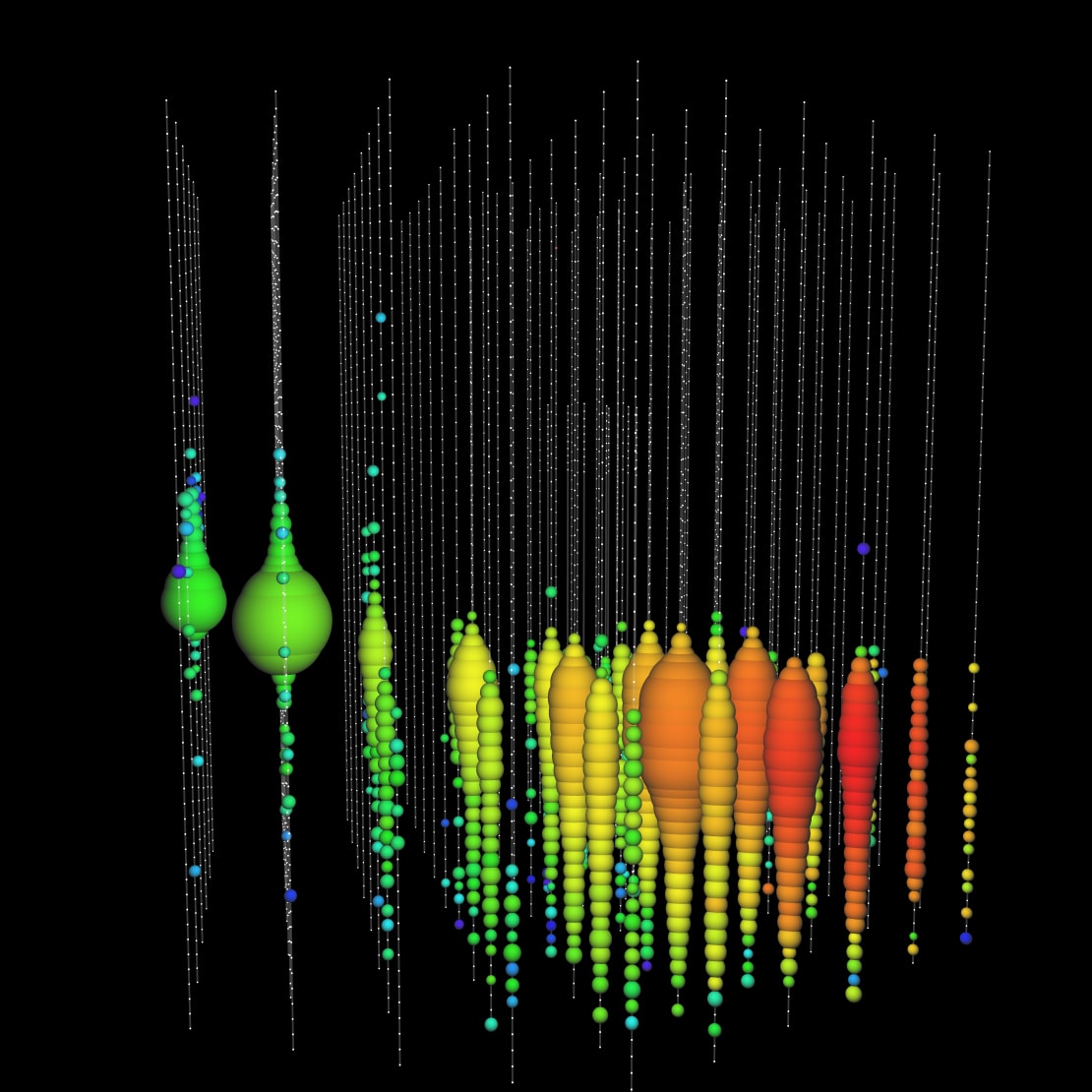The highest energy cosmic rays are known to reach energies a trillion times larger than those of protons in the LHC at CERN. These ultra-high-energy cosmic rays (UHECR) can produce neutrinos with energies above 100 PeV either by the interaction with photons and matter at the source, which are just very high energy astrophysical neutrinos, or by the interaction with the cosmic microwave background (CMB), which are referred to as cosmogenic neutrinos.
The IceCube Collaboration has made public today that a new search for cosmogenic neutrinos resulted in two very high energy neutrinos. These neutrinos, which are found to be of astrophysical origin with a 92.3% probability, include the highest energy neutrino detected to date. While of astrophysical origin, the energy of these neutrinos does not match the expectation for a cosmogenic neutrino flux. The lack of evidence for such events in a search of seven years of IceCube data places very strong constraints on the sources of UHECR. Proton-dominated sources are greatly disfavored, and testing mixed and heavy nuclei cosmic-ray sources will require much bigger instruments, such as an extension of IceCube or radio Askaryan neutrino detectors. These results have been submitted yesterday to Physical Review Letters.

Cosmogenic neutrinos, with energies reaching up to 50 EeV or more, are expected to be the highest energy neutrinos in nature. Their flux is supposed to exceed that of astrophysical neutrinos at energies of at least 100 PeV and above. But no one has ever detected a cosmogenic neutrino, not even a neutrino with an energy above 10 PeV.
The results presented today by the IceCube Collaboration, using data from 2008 to 2015, have once more indicated a fruitless search for cosmogenic neutrinos. And, although this is not a totally unexpected scenario, it does set very strong constraints on the sources of UHECRs.
Previous measurements of the spectrum and chemical composition of UHECRs by HiRes and the Telescope Array suggested a chemical composition compatible with proton-dominated sources up to the highest energies. However, Auger’s results pointed to the need for heavier nuclei UHECR to explain its data. IceCube results now confirm Auger’s hints and reject UHECR sources such as proton-dominated models of active galactic nuclei (AGNs) and gamma-ray bursts (GRBs).
“Many scientists thought that AGNs or GRBs would be the standard scenario of UHECR production,” says Aya Ishihara, an IceCube researcher at Chiba University in Japan and the corresponding author of this work. “But neutrinos are changing our view of the ultra-high-energy universe,” adds Ishihara.
Continued searches should now concentrate on models with weak or no cosmological evolution proton-dominated sources and those with heavier nuclei composition or, as most scientists lean toward, a combination of both. But these scenarios push cosmogenic neutrinos far below the detection threshold of any running detector.
The production of cosmogenic neutrinos in muon and pion decays produced in the interaction of primary cosmic rays with CMB photons is efficient only if UHECR are protons. Models with a strong cosmological evolution of proton-dominated sources predict a flux of cosmogenic neutrinos in IceCube’s sensitivity region above 100 PeV. But these are now rejected by IceCube results.
In the case of heavier nuclei, these CR interactions are suppressed and the neutrino flux falls rapidly with energy. “Neutrinos become more important if UHECRs are heavy nuclei since, due to the unknown magnetic fields in galactic and extragalactic environments, the cosmic rays’ path is even more unpredictable than for protons. But, no matter what, neutrinos always point to their sources,” states Ishihara.
The more UHECRs are heavy nuclei, the smaller the EeV component of the cosmogenic neutrino flux, and the larger the detector required to first detect them. IceCube results strongly support the need for a full deployment of experiments such as ARA and ARIANNA, which are currently either in partial deployment or running as a pilot experiment.
About the two high-energy neutrinos


The search for cosmogenic neutrinos did find two very high energy neutrinos. One is a track with a deposited energy of 2.6 PeV, which had already been found in a previous study and is the highest energy neutrino recorded to date. The second is a partially contained cascade with a deposited energy of 0.77 PeV.
The hypothesis that these events are of cosmogenic origin is rejected by IceCube researchers at more than a 99% confidence level. These are most likely astrophysical neutrinos since the probability of being atmospheric in origin has been determined to be very small.
The track was detected in June 2014 and deposited some energy outside the detector. IceCube scientists estimated that the neutrino that induced this event had an energy about three times greater than what was deposited in the detector, i.e., the energy of the initial neutrino was well above 5 PeV.
+ Info “Constraints on ultra-high-energy cosmic ray sources from a search for neutrinos above 10 PeV with IceCube,” The IceCube Collaboration: M.G.Aartsen et al, Physical Review Letters 117 (2016), journals.aps.org arxiv.org/abs/1607.05886